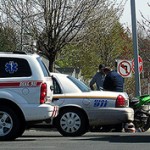 Pop quiz! Do you remember what you are supposed to do when you see or hear an emergency vehicle approaching? If it has been a while since you took your driving exam, here are some sample questions from the DMV exam (the answers are in bold):
Pop quiz! Do you remember what you are supposed to do when you see or hear an emergency vehicle approaching? If it has been a while since you took your driving exam, here are some sample questions from the DMV exam (the answers are in bold):
When do emergency vehicles with flashing lights and sirens have the right of way?
- In intersections.
- While driving on the right side of the road.
- In all circumstances.
- While on your side of a divided median.
When approached by an emergency vehicle with flashing lights and siren in operation, what should you do?
- Ensure that you stay at least 150 meters ahead of the emergency vehicle.
- Stop wherever you are.
- Turn up the volume on the stereo.
- Pull over to the curb and stop.
When approached by an emergency vehicle with flashing lights and siren in operation, under what circumstances is it OK not to stop?
- When on the opposite side of a divided highway median.
- There’s room for the emergency vehicle to pass you.
- When your emergency is more important than theirs.
- When you are able to stay ahead of the emergency vehicle.
How did you do? If you did not do as well as you thought, it is alright. Here is some advice written by our own paramedic Martinovich that should help clear up any questions you may have about what to do when driving and you see some bright lights in your rear view:
Imagine this, it is early evening and you are driving home from work and traffic is pretty heavy. You start to notice vehicles in front of you are pulling over, but you are not sure why. Not thinking anything of it you go around them and then all of a sudden you hear a loud noise and look in your mirrors to see an ambulance with its lights and sirens on. You quickly, and hopefully safely, react and move over.
This is not uncommon at all, and actually it happens on a daily basis. Sometimes you may not be able to hear the sirens, especially in newer vehicles. The sound proofing and technology of newer vehicles is so improved that it deadens the sounds of sirens and air horns. If you see people pulling over be sure to check your mirrors because they may be hearing something you are not.
Some people stop dead in the road, others move to the left, and some move to the right. So what is the right (and legal) thing to do?…..
 Move to the Right and Stop For Lights and Sirens!
Move to the Right and Stop For Lights and Sirens! 
What is an emergency vehicle? An emergency vehicle is defined as a police vehicle, ambulance or fire depart ment vehicle, (i.e. engines, trucks or chief vehicles). These vehicles can be defined by their flashing lights. In New York State, emergency vehicles will have red, white or combination of red and white lights. Most of these vehicles also have reflective designs on them for identification.
ment vehicle, (i.e. engines, trucks or chief vehicles). These vehicles can be defined by their flashing lights. In New York State, emergency vehicles will have red, white or combination of red and white lights. Most of these vehicles also have reflective designs on them for identification.
What to do when approached? When approached by an emergency vehicle, whether from behind you or approaching you, slow down, pull to the right and stop. It is important for you to make the stop because if for some reason that emergency vehicle has to make an  immediate move to the right, to avoid another car not obeying the traffic law, or a pedestrian or animal, you stopping your vehicle will allow them to have the room to appropriately proceed through traffic and not delay their response to the emergency. Just pulling to right and slowing down next to them could cause another accident if any of the above situations arise. Remain stopped on the shoulder of the road until the emergency vehicle has passed you. Be sure to check for additional emergency vehicles before returning into traffic.
immediate move to the right, to avoid another car not obeying the traffic law, or a pedestrian or animal, you stopping your vehicle will allow them to have the room to appropriately proceed through traffic and not delay their response to the emergency. Just pulling to right and slowing down next to them could cause another accident if any of the above situations arise. Remain stopped on the shoulder of the road until the emergency vehicle has passed you. Be sure to check for additional emergency vehicles before returning into traffic.
Take time to review the NYS Traffic Law here.
This is not to be mistaken for the operation of your vehicle when approaching a parked, stopped or standing authorized emergency vehicle. Whenever you approach a police officer on the shoulder or a motor vehicle accident on the road you must use extreme caution and regard to avoid colliding into the vehicles or the personnel working on the side of the road. Slow down and move to the farthest lane from where the incident is taking place. The vehicles will be well marked but sometimes the personnel on the road may not be. Stay aware as you make your way passed the incident! This is a new law that took effect in January 2011. There have been too many injuries and deaths of emergency services providers, police personnel and bystanders from being struck by vehicles not involved in the original incident.
vehicles will be well marked but sometimes the personnel on the road may not be. Stay aware as you make your way passed the incident! This is a new law that took effect in January 2011. There have been too many injuries and deaths of emergency services providers, police personnel and bystanders from being struck by vehicles not involved in the original incident.
Drive safely and stay alert!
